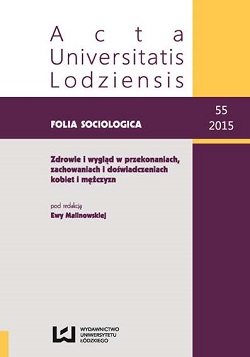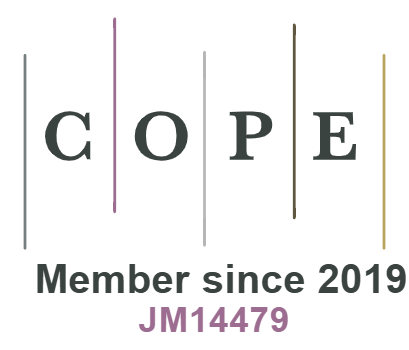Piękno starzejącego się ciała: oczywisty czy pozorny wymiar wartości społecznych?
DOI:
https://doi.org/10.18778/0208-600X.55.02Słowa kluczowe:
starość, obraz ciała, płeć, piękno, kulturaAbstrakt
Celem artykułu jest przegląd teorii i badań empirycznych, dotyczących problematyki społecznego oraz subiektywnego obrazu ciała w procesie starzenia. W sferze publicznej panuje powszechne przekonanie, że wraz z wiekiem obniża się atrakcyjność, a według stereotypu starzy ludzie postrzegani są jako „brzydcy”. Wobec wyzwania, jakim jest starość, seniorzy dążą do utrzymania pozytywnej oceny swojej fizyczności, zarówno w dziedzinie wyglądu, jak i zdrowia. Nowe pokolenia kończące sześćdziesiąty rok życia ucieleśniają zmiany, wyrażające się w postaci dyskretnego wzrostu wydatków, wyższego poziomu aktywności fizycznej, przywiązywania większej wagi do reżimu diety i kondycji fizycznej oraz częstszego szukania pomocy w obszarze kosmetycznych i odmładzających technologii. Przeprowadzone analizy wskazały na to, że efekty naturalnego procesu starzenia podlegają społecznej stygmatyzacji. We współczesnym zachodnim społeczeństwie obsesja na punkcie młodzieńczego, pięknego wyglądu stała się powszechna, a jej rezultatem są procedury zmierzające do odwrócenia procesu starzenia. Potrzeba estetyzacji ciał i medialne epatowanie pięknem cenzurują starość w wymiarze cielesnym. W artykule szczególną uwagę poświęcono zagadnieniom zróżnicowania płciowego w kontekście starości. O ile można znaleźć liczne przykłady mężczyzn, będących bohaterami kultury masowej, którym „pozwolono” się zestarzeć, o tyle w przypadku kobiet obowiązkowe jest bycie „wiecznie młodą”.
Bibliografia
Baker L, Gringart E. (2009), Body image and self-esteem in older adulthood, “Ageing and Society”, Vol. 29, No. 6, s. 977–995.
Google Scholar
DOI: https://doi.org/10.1017/S0144686X09008721
Bessenoff G. R, Del Priore R. E. (2007), Women, weight, and age: Social comparison to magazine images across the lifespan, “Sex Roles”, Vol. 56, No. 3/4, s. 215–222.
Google Scholar
DOI: https://doi.org/10.1007/s11199-006-9164-2
Biskupski J. (2015), Kolorowy ptak, „Viva!”, nr 12, 2 czerwca, s. 54–59.
Google Scholar
Bois J.-P. (1996), Historia starości. Od Montaigne’a do pierwszych emerytur, t. 2, Oficyna Wydawnicza Volumen, Wydawnictwo Marabut, Warszawa.
Google Scholar
Bond J., Peace S., Westerhof G., T ulle E. (2007), Meanings of aging and old age: Discursive contexts, social attitudes and personal identities, [w:] F. Dittmann-Kohli, G. Westerhof (eds.), Ageing in Society. European Perspectives on Gerontology, Sage Publications, London, s. 235–254.
Google Scholar
DOI: https://doi.org/10.4135/9781446278918.n11
Bordo S. (2003), The Unbearable Weight, Feminism, Western Culture and the Body, University of California Press, Berkeley – Los Angeles – London.
Google Scholar
Borowicz S. (2010), Maska Sylenis, [w:] S. Borowicz, J. Hobot, R. Przybylska (red.), Stara rebeliantka. Studia nad semantyką obrazu, Wydawnictwo Uniwersytetu Jagiellońskiego, Kraków, s. 17–39.
Google Scholar
Borowicz S., Przybylska R. (2010), „O winożłopki! O baby pijaczki”. Językowy obraz „pijanej staruchy” w literaturze antycznej, [w:] S. Borowicz, J. Hobot, R. Przybylska (red.), Stara rebeliantka. Studia nad semantyką obrazu, Wydawnictwo Uniwersytetu Jagiellońskiego, Kraków, s. 43–91.
Google Scholar
Botelho L. A. (2005), The 17th Century, [w:] P. Thane, A History of Old Age, Thames & Hudson, London, s. 113–174.
Google Scholar
Brooks A. T. (2010), Aesthetic anti-ageing surgery and technology: Women’s friend or foe?, “Sociology of Health and Illness”, Vol. 32, No. 2, s. 238–257.
Google Scholar
DOI: https://doi.org/10.1111/j.1467-9566.2009.01224.x
Clark K. (1956), Akt. Studium idealnej formy, PWN, Warszawa.
Google Scholar
Crossley N. (2006), Reflexive Embodiment in Contemporary Society, Open University Press, Buckingham.
Google Scholar
Eco U. (2007a), Historia piękna, Dom Wydawniczy Rebis, Poznań.
Google Scholar
Eco U. (2007b), Historia brzydoty, Dom Wydawniczy Rebis, Poznań.
Google Scholar
Etcoff N. (2000), Przetrwają najpiękniejsi, Wydawnictwo W.A.B., Warszawa.
Google Scholar
Featherstone M. (2008), Ciało w kulturze konsumpcyjnej, [w:] A. Chałupnik, J. Jaworska, J. Kowalska-Leder, I. Kur z, M. Szpakowska (oprac.), Antropologia ciała. Zagadnienia i wybór tekstów, Wydawnictwa Uniwersytetu Warszawskiego, Warszawa, s. 109–117.
Google Scholar
Furman F. K. (1997), Facing the mirror: Older women and beauty shop culture, Routledge, New York.
Google Scholar
Giddens A. (2001), Nowoczesność i tożsamość. „Ja” i społeczeństwo w epoce późnej nowoczesności, Wydawnictwo Naukowe PWN, Warszawa.
Google Scholar
Giddens A. (2009), Europa w epoce globalnej, Wydawnictwo Naukowe PWN, Warszawa.
Google Scholar
Gough B. (2007), “Real men don’t diet”: An analysis of contemporary newspaper representations of men, food, and health, “Social Science and Medicine”, Vol. 64, No. 2, s. 326–337.
Google Scholar
DOI: https://doi.org/10.1016/j.socscimed.2006.09.011
Hołdys Z. (2014), Wielki tyłek z botoksu, „Newsweek”, nr 24, 9–15 czerwca, s. 61.
Google Scholar
Hurd Clarke L. (2002), Beauty in later life: Older women’s perceptions of physical attractiveness, “Canadian Journal on Aging”, Vol. 21, No. 3, s. 429–442.
Google Scholar
DOI: https://doi.org/10.1017/S0714980800001744
Hurd Clarke L. (2010), Facing age: Women growing older in an anti-aging culture, Rowman and Littlefield, Toronto, Ontario.
Google Scholar
Hurd Clarke L., Griffin M. (2008), Visible and invisible ageing: Beauty work as a response to ageism. “Ageing and Society”, Vol. 28, No. 5, s. 653–674.
Google Scholar
DOI: https://doi.org/10.1017/S0144686X07007003
Huxley C., Hayfield N. (2012), Non-heterosexual sexualities: The role of sexual identity in appearance and body image, [w:] N. Rumsey, D. Harcourt (eds.), Oxford Handbook of the Psychology of Appearance, Oxford University Press, Oxford, s. 190–202.
Google Scholar
DOI: https://doi.org/10.1093/oxfordhb/9780199580521.013.0017
Jakubowska H. (2009), Socjologia ciała, Wydawnictwo Naukowe WAM, Poznań.
Google Scholar
Johnston O., Reilly J., Kremer J. (2004), Women’s experiences of appearance concern and body control across the lifespan: Challenging the accepted wisdom, “Journal of Health Psychology”, Vol. 9, No. 3, s. 397–410.
Google Scholar
DOI: https://doi.org/10.1177/1359105304042349
Kinnunen T. (2010), “A second youth”: Pursuing happiness and respectability through cosmetic surgery in Finland, “Sociology of Health and Illness”, Vol. 32, No. 2, s. 258–271.
Google Scholar
DOI: https://doi.org/10.1111/j.1467-9566.2009.01215.x
Kluczyńska U. (2008), Redefiniowanie męskości. Kulturowo-społeczne konteksty starzenia się mężczyzn, [w:] J. Kowalski, P. Szukalski (red.), Pomyślne starzenie się w perspektywie nauk społecznych i humanistycznych, Zakład Demografii i Gerontologii Społecznej Uniwersytetu Łódzkiego, Łódź, s. 76–88.
Google Scholar
Krekula C. (2007), The intersection of age and gender: Reworking gender theory and social gerontology, “Current Sociology”, Vol. 55, No. 2, s. 155–171.
Google Scholar
DOI: https://doi.org/10.1177/0011392107073299
La Ceda F. (2014), Szorstkim być. Antropologia mężczyzny, Wydawnictwo Sic!, Warszawa.
Google Scholar
Lasch C. (1991), The Culture of Narcissism. American Life in an Age of Diminishing Expectations, W. W. Norton, New York.
Google Scholar
Levesque M. J., Vichesky D. (2006), Raising the bar on the body beautiful: An analysis of the body image concerns of homosexual men, “Body Image”, Vol. 3, No. 1, s. 45–55.
Google Scholar
DOI: https://doi.org/10.1016/j.bodyim.2005.10.007
McLaren L., Kuh D. (2004), Women’s body dissatisfaction, social class, and social mobility, “Social Science and Medicine”, Vol. 58, No. 9, s. 1575–1584.
Google Scholar
DOI: https://doi.org/10.1016/S0277-9536(03)00209-0
Michaud Y. (2014), Wizualizacje. Ciało i sztuki wizualne, [w:] J.-J. Courtine (red.), Historia ciała, t. 3, Wydawnictwo słowo/obraz terytoria, Gdańsk, s. 391–410.
Google Scholar
Minois G. (1995), Historia starości: od antyku do renesansu, t. 1, Oficyna Wydawnicza Volumen, Wydawnictwo Marabut, Warszawa.
Google Scholar
Morrison M. A., Morrison T. G., Sager C. (2004), Does body satisfaction differ between gay and lesbian and heterosexual men and women? A meta-analytical review, “Body Image”, Vol. 1, No. 2, s. 127–138.
Google Scholar
DOI: https://doi.org/10.1016/j.bodyim.2004.01.002
Muise A., Desmarais S. (2010), Women’s perceptions and use of ‘anti-aging’ products, “Sex Roles”, Vol. 63, No. 1–2, s. 126–137.
Google Scholar
DOI: https://doi.org/10.1007/s11199-010-9791-5
Nead L. (1998), Akt kobiecy. Sztuka, obscena i seksualność, Dom Wydawniczy Rebis, Poznań.
Google Scholar
Ostrowska A., Stępień B. (2015), Fantastyczna czterdziestka. Poradnik pozytywnego życia, Wydawnictwo Helion, Gliwice.
Google Scholar
Pawlikowska K., Maison D. (2014), Polki. Spełnione profesjonalistki, rodzinne panie domu czy obywatelki świata?, Wydawnictwa Uniwersytetu Warszawskiego, Warszawa.
Google Scholar
DOI: https://doi.org/10.31338/uw.9788323516989
Pawłowski B. (2009), Biologia atrakcyjności człowieka jako przedmiot badań naukowych, [w:] B. Pawłowski (red.), Biologia atrakcyjności człowieka, Wydawnictwa Uniwersytetu Warszawskiego, Warszawa, s. 1–10.
Google Scholar
DOI: https://doi.org/10.31338/uw.9788323511854.pp.1-11
Pawłowski B., Sukiennik I. (2009), Biologia atrakcyjności zapachu ludzkiego ciała, [w:] B. Pawłowski (red.), Biologia atrakcyjności człowieka, Wydawnictwa Uniwersytetu Warszawskiego, Warszawa, s. 263–291.
Google Scholar
DOI: https://doi.org/10.31338/uw.9788323511854.pp.262-292
Reddy S. L. (2013), Understanding the Body Image Experiences of Older Men, “International Journal of Humanities and Social Science”, Vol. 3, No. 9, s. 34–42.
Google Scholar
Shilling Ch. (2010), Socjologia ciała, Wydawnictwo Naukowe PWN, Warszawa.
Google Scholar
Smolińska I. (2015), Lubię starość, „Wprost”, nr 2, 5–11 stycznia, s. 45–47.
Google Scholar
Sontag S. (1997), The double standard of aging, [w:] M. Pearsall (ed.), The other within us: Feminist explorations of women and aging, Westview Press, Boulder, CO, s. 19–24.
Google Scholar
DOI: https://doi.org/10.4324/9780429496059-2
Stojek-Sawicka K. (2013), Szlachcianki w świecie sarmackim. Jak żyły kobiety na dworach szlacheckich w dawnej Polsce?, Wydawnictwo Bellona, Warszawa.
Google Scholar
Szatur-Jaworska B. (red.) (2014), O sposobach mówienia o starości. Debata, analiza, przykłady, Biuro Rzecznika Praw Obywatelskich, Warszawa.
Google Scholar
Szukalski P. (2012), Ageizm – dyskryminacja ze względu na wiek, [w:] P. Szukalski (red.), Solidarność pokoleń. Dylematy relacji międzypokoleniowych, Wydawnictwo Uniwersytetu Łódzkiego, Łódź, s. 139–178.
Google Scholar
Tiggemann M., Martins Y., Kirkbride A. (2007), Oh to be lean and muscular: Body image ideals in gay and heterosexual men, “Psychology of Men and Masculinity”, Vol. 8, No. 1, s. 15–24.
Google Scholar
DOI: https://doi.org/10.1037/1524-9220.8.1.15
Turner B. S. (1996), The Body and Society. Explorations in Social Theory, Second Edition, Sage Publications, Thousand Oaks, New Delhi.
Google Scholar
Twigg J. (2013), Fashion and Age: Dress, the Body and Later Life, Bloomsbury Academic, London.
Google Scholar
DOI: https://doi.org/10.2752/9781474290340
Warner H. (2014), Fashion on Television. Identity and Celebrity Culture, Bloomsbury, London – New York.
Google Scholar
DOI: https://doi.org/10.5040/9781350051126
Zych A. A. (2013), Przekraczając „smugę cienia”. Szkice z gerontologii i tanatologii, wyd. 2, Wydawnictwo Naukowe Śląsk, Katowice.
Google Scholar
http://advancedstyle.blogspot.com (19.08.2015).
Google Scholar
http://fashion50plus.pl (19.08.2015).
Google Scholar
http://informacje.havasworldwide.pl/pr/297103/polacy-patrza-w-lustro-z-optymizmem-wyniki-badania-prosumer-report (24.08.2015).
Google Scholar
http://stylizacjeewy.blogspot.com (3.09.2015).
Google Scholar
http://www.pinterest.com/stylissimapl/hair-for-mature-women-going-grey (27.08.2015).
Google Scholar
Pobrania
Opublikowane
Jak cytować
Numer
Dział
Licencja
Prawa autorskie (c) 2015 © Copyright by Mariola Bieńko, Łódź 2015; © Copyright for this edition by Uniwersytet Łódzki, Łódź 2015

Utwór dostępny jest na licencji Creative Commons Uznanie autorstwa – Użycie niekomercyjne – Bez utworów zależnych 4.0 Międzynarodowe.










